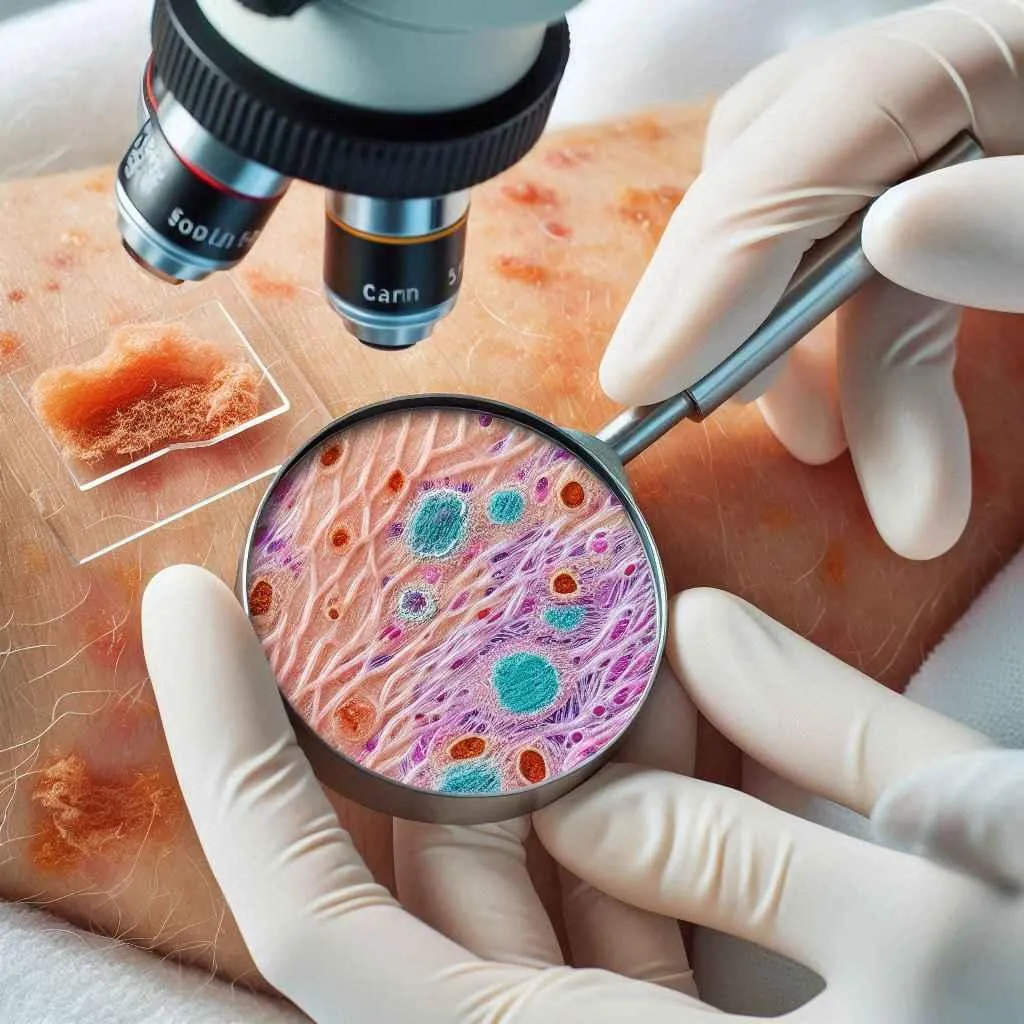St. Pete Location
Bradenton Location
Patient Education
We're passionate about helping people achieve their healthiest, happiest skin. Whether you're struggling with acne, eczema, rosacea, or any other skin concern, we're here to offer support, information, and inspiration.

Fungal Skin Infections: Preventing, and Treating Common Conditions | Leah Michel, APRN, FNP-BC
Fungal Skin Infections: Preventing, and Treating Common Conditions

Fungal skin infections are a widespread health concern affecting millions of people worldwide. These infections, caused by various types of fungi, can lead to discomfort, irritation, and in some cases, more severe health complications. In this comprehensive blog post, we'll explore the nature of fungal skin infections, their common types, prevention strategies, and treatment options.
Understanding Fungal Skin Infections
Fungal skin infections, also known as mycoses, are caused by fungi that invade and multiply within the skin. These microorganisms thrive in warm, moist environments, making certain areas of the body particularly susceptible (1). While many fungi naturally exist on our skin without causing harm, an overgrowth or invasion by pathogenic fungi can lead to infection.
Recent research has shown an alarming increase in the prevalence of fungal infections worldwide. A 2023 study published in the Journal of Fungi reported that over 150 million cases of severe fungal infections occur annually, resulting in approximately 1.7 million fatalities globally (2). This rise in fungal infections, including those affecting the skin, highlights the importance of understanding and addressing these conditions.
Common Types of Fungal Skin Infections
Athlete's Foot (Tinea Pedis)
Athlete's foot is one of the most prevalent fungal skin infections, typically affecting the spaces between the toes and the soles of the feet. It's caused by dermatophytes, particularly Trichophyton rubrum (1). Some of its symptoms include burning, itching, and scaling of the skin.
Jock Itch (Tinea Cruris)
Jock itch impacts the groin area and inner thighs. It's characterized by a red, itchy rash with a scaly border. Like athlete's foot, it's primarily caused by dermatophytes (3).
Ringworm (Tinea Corporis)
Although its name suggests otherwise, ringworm is not caused by a worm; rather, it is the result of a fungal infection. It appears as a circular, red, scaly patch on the skin that can occur anywhere on the body (5).
Candidiasis
Candidiasis is caused by an overgrowth of Candida yeast, which naturally exists on the skin. It commonly affects moist areas of the body, such as skin folds, and can cause a red, itchy rash (2).
This condition, caused by the yeast Malassezia, results in discolored patches on the skin, often on the chest, back, and upper arms (2).
Risk Factors and Causes
Several factors can increase the risk of developing fungal skin infections:
Warm, humid environments
Excessive sweating
Poor hygiene
Tight, non-breathable clothing
Weakened immune system
Diabetes
Obesity
Frequent use of public facilities like swimming pools or gyms
Prevention Strategies
Preventing fungal skin infections involves maintaining good hygiene and creating an environment unfavorable for fungal growth. Here are some effective prevention strategies:
Keep the skin clean and dry, especially in areas prone to sweating (3).
Wear breathable, moisture-wicking clothing and footwear (3).
Change out of wet or sweaty clothes right away.
Use antifungal powders in shoes and on feet.
Avoid walking barefoot in public areas like locker rooms and swimming pools.
Don't share personal items like towels, combs, or shoes.
Maintain a healthy weight and control blood sugar levels if diabetic (5).
Diagnosis and Treatment
Diagnosis
Diagnosing fungal skin infections typically involves a physical examination and may include:
Skin scraping for microscopic examination
Fungal culture
Wood's lamp examination (for certain types of infections)
In some cases, a skin biopsy (9)
Treatment Options
Treatment for fungal skin infections has evolved significantly in recent years. A 2022 review in the Journal of Fungi highlighted the following treatment approaches:
Topical Antifungal Medications: These remain the first-line treatment for most superficial fungal infections. Common agents include azoles (e.g., clotrimazole, miconazole), allylamines (e.g., terbinafine), and ciclopirox (4).
Oral Antifungal Medications: For more severe or resistant infections, oral antifungals like terbinafine, itraconazole, or fluconazole may be prescribed (4).
Combination Therapy: Some cases benefit from combining topical and oral medications for enhanced efficacy (4).
Novel Treatments: Recent research has explored new treatment modalities, including:
Photodynamic therapy
Nanoparticle-based drug delivery systems
Natural antifungal compounds derived from plants (4)
Lifestyle Modifications: Alongside medication, patients are often advised to make lifestyle changes to support treatment and prevent recurrence (3).
Emerging Challenges and Research Directions
The landscape of fungal skin infections is evolving, presenting new challenges for healthcare providers and researchers:
Antifungal Resistance
A growing concern in the medical community is the emergence of antifungal-resistant strains of fungi. A 2023 study published in Nature Microbiology reported an increase in resistant Candida species, particularly in healthcare settings (6). This trend highlights the importance of developing new antifungal medications and treatment approaches.
Climate Change Impact
Recent research has suggested a link between climate change and the increasing prevalence of certain fungal infections. A 2022 review in The Lancet Microbe discussed how rising global temperatures might expand the geographical range of thermotolerant fungi, potentially leading to new patterns of fungal skin infections (7).
Innovative Treatment Approaches
Researchers are exploring novel treatment approaches to combat fungal skin infections:
Immunotherapy: Studies are investigating the potential of enhancing the body's immune response to fight fungal infections more effectively (8).
Probiotic Therapies: Some research is focusing on using beneficial microorganisms to prevent or treat fungal overgrowth on the skin (8).
Gene Therapy: Early-stage research is exploring the possibility of modifying genes to increase resistance to fungal infections (8).
Special Considerations
Fungal Infections in Immunocompromised Patients
Individuals with weakened immune systems, such as those with HIV/AIDS or undergoing chemotherapy, are at higher risk for severe and recurrent fungal infections. A 2021 study in the Journal of Fungi emphasized the need for tailored prevention and treatment strategies for this vulnerable population (10).
Pediatric Fungal Infections
Children can be particularly susceptible to certain fungal skin infections, like tinea capitis (scalp ringworm). A 2023 review in Pediatric Dermatology highlighted the importance of early diagnosis and appropriate treatment in pediatric cases to prevent complications and transmission (11).
Why Choose My Skin St Pete?
Expertise in Dermatology
Leah Michel, APRN, FNP-BC, at My Skin in St. Petersburg and Bradenton, Florida, is a highly qualified professional specializing in dermatology, particularly in the treatment of fungal skin infections. .
Comprehensive Care
My Skin offers a wide range of dermatological services beyond just fungal infections, including treatments for acne, psoriasis, eczema, and skin cancer. This comprehensive approach allows for holistic patient care, addressing multiple skin concerns in one place.
Personalized Treatment Plans
At My Skin, the focus is on individualized care. Leah takes the time to understand each patient's unique situation, ensuring that treatment plans are customized to achieve the best possible outcomes while minimizing side effects.
Advanced Techniques and Technologies
The clinic utilizes the latest medical technologies and techniques to provide effective treatments. This includes minimally invasive procedures that reduce recovery time and scarring, which is particularly beneficial for patients concerned about the aesthetics of their skin.
Accessibility and Convenience
Located conveniently in downtown St. Petersburg and Bradenton, My Skin is easily accessible for patients in the area. They accept Medicare and most commercial insurances, making quality skin care more affordable.
Commitment to Patient Education
Leah Michel emphasizes patient education, helping individuals understand their conditions and the importance of treatment compliance. This empowers patients to take an active role in their skin health.
Positive Patient Experiences
With a focus on creating a welcoming environment, My Skin has garnered positive reviews from patients who appreciate the attentive service and effective treatments they receive. This commitment to patient satisfaction reflects the clinic's dedication to quality care.
For anyone dealing with fungal skin infections or other dermatological issues, Leah Michel at My Skin provides expert care with a compassionate approach, making it an excellent choice for treatment.
Conclusion
Fungal skin infections remain a significant health concern, affecting millions worldwide. While common types like athlete's foot and ringworm are well-known, the landscape of these infections is changing. Emerging resistant strains, the impact of climate change, and the development of new treatment modalities are shaping the future of fungal infection management.
As research continues to advance our understanding of these conditions, it's crucial for individuals to remain vigilant about prevention and seek prompt medical attention when symptoms arise. Healthcare providers must stay informed about the latest developments in diagnosis and treatment to provide optimal care.
By combining good hygiene practices, early intervention, and innovative treatments, we can hope to reduce the burden of fungal skin infections and improve quality of life for those affected. As we move forward, continued research and public health efforts will be essential in addressing the evolving challenges posed by fungal skin infections.
References:
Fungal diseases. (2024, May 8). Fungal Diseases.
Seladi-Schulman, J., PhD. (2023, May 19). Everything you need to know about fungal skin infections. Healthline.
Ely, J. W., et al. (2020). Diagnosis and Management of Tinea Infections. American Family Physician, 102(3), 158-164.
Ho, F. K., Bolhuis, A., & Delgado-Charro, M. B. (2021). Prevention and treatment of fungal skin infections using cationic polymeric films. Pharmaceutics, 13(8), 1161.
Key, A. P. (2024, June 12). Fungal infections of the skin. WebMD.
About fungal diseases. (2024, May 8). Fungal Diseases.
Garcia-Solache, M. A., & Casadevall, A. (2022). Global warming will bring new fungal diseases for mammals. The Lancet Microbe, 3(4), e245-e254.
Rise in global fungal drug-resistant infections. (2024, March 24). ScienceDaily.
Aaron, D. M. (2023, September 11). Overview of fungal skin infections. Merck Manual Consumer Version.
Contreras, B. (2024, June 13). New, Difficult-to-Treat fungal skin infections are emerging, clinicians warn. Dermatology Times
Bupa. (2023, November 21). Fungal Skin Infections
Disclaimer:
The information on this website is provided for educational and information purposes only and is not medical advice. Always consult with a licensed medical provider and follow their recommendations regardless of what you read on this website. If you think you are having a medical emergency, dial 911 or go to the nearest emergency room. Links to other third-party websites are provided for your convenience only. If you decide to access any of the third-party websites, you do so entirely at your own risk and subject to the terms of use for those websites. Neither My Skin by Leah Michel, APRN, FNP-BC, nor any contributor to this website, makes any representation, express or implied, regarding the information provided on this website or any information you may access on a third-party website using a link. Use of this website does not establish a doctor-patient relationship. If you would like to request an appointment with a health care provider, please call our office at (727) 295-7223.
If you have any questions or concerns about your skin & would like to schedule an appointment at our St. Pete dermatology office or Brandenton dermatology office, please call us today!
St. Pete Location
111 2nd Ave NE., Suite 1406
St Petersburg, FL 33701
Plaza Tower- Downtown St Pete
Phone: (727) 295-7223
Bradenton Location
4301 32nd St. W., Suite D2
Bradenton, FL 34277
Phone: (941) 330-5805







